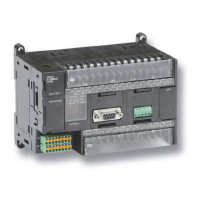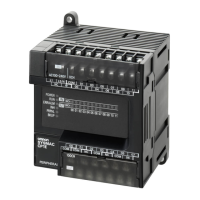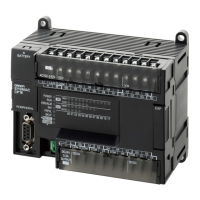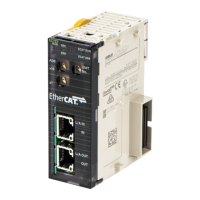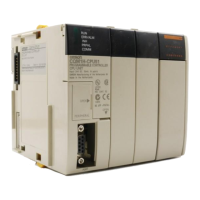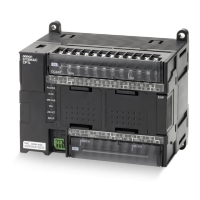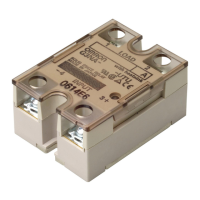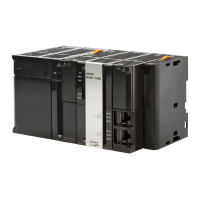199
Pulse Outputs Section 5-2
Perform origin search
and origin return opera-
tions.
Origin functions (Origin search and
origin return)
Origin search and origin return operations can be exe-
cuted through pulse outputs.
• Origin search:
To start the origin search, set the PLC Setup to
enable the origin search operation, set the various
origin search parameters, and execute the ORIGIN
SEARCH instruction (ORG(889)). The Unit will deter-
mine the location of the origin based on the Origin
Proximity Input Signal and Origin Input Signal. The
coordinates of the pulse output's PV will automatically
be set as the absolute coordinates.
• Origin return:
To return to the predetermined origin, set the various
origin return parameters and execute the ORIGIN
SEARCH instruction (ORG(889)).
Change the target posi-
tion during positioning.
(For example, perform
an emergency avoid
operation with the Multi-
ple Start feature.)
Positioning with the PLS2(887)
instruction
When a positioning operation started with the PULSE
OUTPUT (PLS2(887)) instruction is in progress, another
PLS2(887) instruction can be executed to change the
target position, target speed, acceleration rate, and
deceleration rate.
Change speed in steps
(polyline approxima-
tion) during speed con-
trol.
Use the ACC(888) instruction (con-
tinuous) to change the acceleration
rate or deceleration rate.
When a speed control operation started with the
ACC(888) instruction (continuous) is in progress,
another ACC(888) instruction (continuous) can be exe-
cuted to change the acceleration rate or deceleration
rate.
Change speed in steps
(polyline approxima-
tion) during positioning.
Use the ACC(888) instruction (inde-
pendent) or PLS2(887) to change the
acceleration rate or deceleration rate.
When a positioning operation started with the ACC(888)
instruction (independent) or PLS2(887) instruction is in
progress, another ACC(888) (independent) or
PLS2(887) instruction can be executed to change the
acceleration rate or deceleration rate.
Perform fixed distance
feed interrupt.
Execute positioning with the
PLS2(887) instruction during an
operation started with SPED(885)
(continuous) or ACC(888) (continu-
ous).
When a speed control operation started with the
SPED(885) instruction (continuous) or ACC(888)
instruction (continuous) is in progress, the PLS2(887)
instruction can be executed to switch to positioning, out-
put a fixed number of pulses, and stop.
After determining the
origin, perform position-
ing simply in absolute
coordinates without
regard to the direction
of the current position
or target position.
The positioning direction is selected
automatically in the absolute coordi-
nate system.
When operating in absolute coordinates (with the origin
determined or INI(880) instruction executed to change
the PV), the CW or CCW direction is selected automati-
cally based on the relationship between the pulse output
PV and the pulse Output Amount specified when the
pulse output instruction is executed.
Perform triangular con-
trol.
Positioning with the ACC(888)
instruction (independent) or
PLS2(887) instruction.
When a positioning operation started with the ACC(888)
instruction (independent) or PLS2(887) instruction is in
progress, triangular control (trapezoidal control without
the constant-speed plateau) will be performed if the
number of output pulses required for acceleration/decel-
eration exceeds the specified target pulse Output
Amount.
(The number of pulses required for acceleration/deceler-
ation equals the time required to reach the target fre-
quency x the target frequency.)
Use variable duty factor
outputs for time-propor-
tional temperature con-
trol.
Control with analog inputs and the
variable duty factor pulse output func-
tion (PWM(891)).
Two built-in outputs can be used as PWM(891) outputs 0
and 1 by executing the PWM(891) instruction.
Purpose Function Description
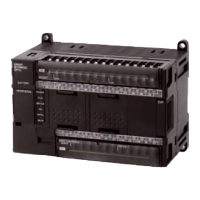
